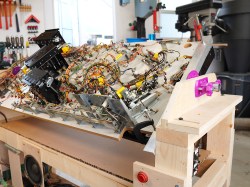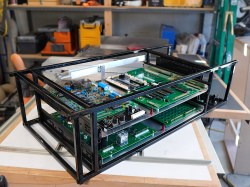Like many of us, [BuildXYZ] has always wanted to own a pinball machine, but doesn’t have the space to justify buying such a big and heavy toy. But where there’s a will, there’s a way. [BuildXYZ] figured that if they could build a pinball machine into a coffee table form factor, they’d be at least halfway to justification.
[BuildXYZ] didn’t choose just any pin. After doing a bunch of research, they settled on 1981’s Bally Centaur because it’s an early solid-state machine, and it’s one of the best. It has no secondary playfield levels to deal with, making it much easier to do this project.
Where do we even start to describe this beautiful labor of love? There are too many details to list, but know that it seems to be equal amounts of restoration work and custom work that brought this table together. The build video after the break is definitely worth your time, and you’ll gain a much better appreciation of the amount of time that went into this, from the custom score decoder chip built on an FPGA to the 3D printed replacement drop targets and new acrylic bits to replace the yellowing ones from the playfield.
[BuildXYZ] started by building a pintisserie, which is exactly what it sounds like — a rotating barbecue spit for a pinball machine’s guts that makes it a breeze to work on. This maintenance-friendliness reappears in the new cabinet design, where the circuit boards are screwed to a pair of drawers.
No, you don’t have to play it flat. But you do have to clear off the top before pressing Start, because a pair of mini industrial linear actuators raise the back end by 5-7° depending on the setting. We were a little sad about the lack of plunger, but [BuildXYZ] is right — it would knock at your kneecaps. On the bright side, [BuildXYZ] reused the ‘free ball’ solenoid as the ball launcher, which is driven by that shiny metal button. Again, be sure to check it out after the break.
Honestly, we haven’t seen this much work go into a pinball machine since this one, built entirely from K’nex.


















Aaaaargh ! What did you do with the backglass ?!! It’s not just for the scores – it has the most important part of the artwork.
I agree, it’s not a real pinball machine, it’s a mere bagatelle.
Hercule Poirot, what are you doing on hackaday?
“We were a little sad about the lack of plunger, but [BuildXYZ] is right — it would knock at your kneecaps”
And the zillion metal spikes won’t?
Move to the midwest and get a home with a basement – then you have plenty of room for a pinball machine – and a pool table, and a bar, and a MAME machine, and a jukebox,,,,,
Agreed! I am a Midwest girl with a full home arcade in my basement, and bar, and gym, and dance floor…😁
This is beautiful, but such a crime to destroy one of my favorite tables like this.
I’m not the one who says “not a hack” and I suppose this is a hack in some ways. But not in the ways of us hackers.
It looks great and so it should with all the resources that went into it. But is definitely a “I did this for youtube subs” than an “I did this as a hacker” sort of thing.
A hacker would do more “creative restoring” and less thousand dollar replacing.
I made a multi arcade game coffee table. It was simple and robust even though I’m not a wood worker. It looked good but that was a result of time and patience not money. It have a minimal number or parts, to break down and need replacing and the most custom things were a modified PC power supply with less wires coming out of it and a custom wiring harness that followed the well known and accepted JAMMA standard.
Just imaging trying to fix this Bally Centaur when it breaks down. This is definitely not a project for everyone.
Early Pin Ball machined didn’t have any electronics. I built a “poor quality” Pin Ball machine as a kid. Hand winding solenoids. You could do a much better job today with the assistance of 3D printing and that would be a “hack”.
Some pics of my coffee table arcade game:
https://hackaday.io/project/3479-arcade-game-table
Brings back memories of my time repairing pinball machines when I was in sixth form and a few years after that. A local guy had a number of pinball machines at some seaside resorts and a few bars. Being a bit of a technical nerd with some mechanical understanding, I managed to get this fun and interesting job.
Once a week I would go around to the pinball machines, get the coins out, count them and pay the owner of the venue where it was placed a percentage of the take. I would clean and test the machines and leave a few free games for the (typically) boys in the venue to have a go. (Pinball pusher, or what?)
The old ones where purely electromechanical with relays doing the tallying and different “challenges” during play. Machines from one Italian company (I cannot remember their name, probably for the better as I don’t want to swear) had a recurring problem due to the way they had constructed the machines. Two relays were at some point activated at the same time but the machine would only work if one closed the circuit before the other, which meant that I often had to readjust the contacts using feeler blades/gap gauges and needle pliers to bend the contacts. Yikes!
It was quite a fun student job, actually.
Big props for amazing work. Having built a pinball machine from scratch, running off a mac mini with all new circuit boards and play field, I know how much work is involved. You rocked this project. Nice work!